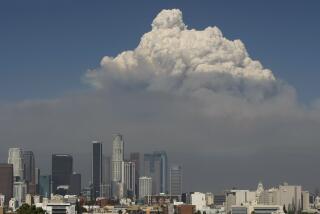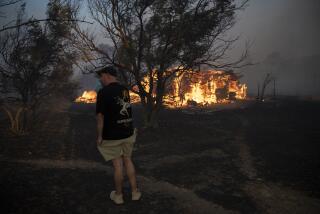California fire tornadoes catch the eye, but just what is a ‘firenado’?
While crews continue to battle raging wildfires in San Diego County, many on social media have been highlighting the tornado-like flaming vortexes captured in photos from the front lines.
Known in the science community as a fire whirl, on social media they’ve become popularly known as “fire tornado” and “firenado.” But a host of studies over the years have shown fire whirls are nothing new. In fact, the phenomena have been documented, and feared, for more than 100 years, according to a 2012 article in the Journal of Combustion.
A fire whirl during the Great Chicago Fire of 1871 threw burning planks of wood more than 600 yards ahead of the main blaze, helping the fire’s spread. That same day in Wisconsin, two people were killed when a fire whirl lifted their home off its foundation and dropped it 50 yards away, according an article published in the journal.
The deadliest fire whirl on record occurred in Japan in 1923 after the Great Kanto 7.9 earthquake. Survivors of the devastating temblor were corralled into an open space by flames spreading across the city, but then a massive fire whirl formed and swept over the area, killing thousands in just minutes, the article’s authors reported.
“It’s just like a spinning column of flames,” Michael Watkins, a forecaster with the National Weather Service in San Diego, said of the phenomenon.
But how and why fire whirls form varies, according to reports.
A fire whirl can occur when trees, a hillside or even a wall of flames forces air to shift or rotate among competing air temperatures and speeds -- and eventually it tilts the rotating air from a horizontal position to a vertical one, giving it the tornado-like appearance.
Some fire whirls dissipate moments after starting because the heat and air flow that maintained them ventilate out. But others can travel and sustain themselves as the heat is lifted on buoyant air, and gas surrounding the whirl pushes it tighter into itself, making it more intense. The air inside the funnel can then act as a solid, rotating column of gas, according to the study.
Scientists estimate fire whirls burn fuel three to seven times faster than an open flame.
More to Read
Sign up for Essential California
The most important California stories and recommendations in your inbox every morning.
You may occasionally receive promotional content from the Los Angeles Times.











